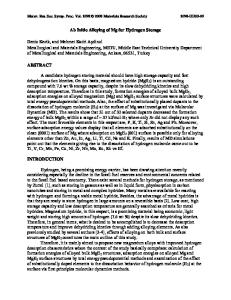Hydrogen adsorbed in ab initio computationally simulated nanoporous carbon. An energetics study
- PDF / 994,572 Bytes
- 6 Pages / 612 x 792 pts (letter) Page_size
- 87 Downloads / 276 Views
1042-S03-28
Hydrogen adsorbed in ab initio computationally simulated nanoporous carbon. An energetics study. R. M. Valladares1, Alexander Valladares1, A. G. Calles1, and Ariel A. Valladares2 1 Facultad de Ciencias, Universidad Nacional Autonoma de Mexico, Apartado Postal 70-542, Ciudad Universitaria, Mexico D.F., 04510, Mexico 2 Instituto de Investigaciones en Materiales, Universidad Nacional Autonoma de Mexico, Apartado Postal 70-360, Ciudad Universitaria, Mexico D.F., 04510, Mexico
ABSTRACT Nanoporous carbon has been considered an interesting and potentially useful material for storing hydrogen. Using nanoporous carbon periodic supercells with 216 atoms and 50 % porosity, constructed with a novel ab initio approach devised by us, the dangling bonds of the carbon atoms were first saturated with hydrogen, then relaxed and its total energy calculated with and without hydrogen. Next the same number of hydrogen atoms, in molecular form, was randomly placed within the pore of the pure carbon supercell, then the sample relaxed, and finally its total energy calculated, also with and without hydrogens. From these results the average energy per hydrogen atom is obtained for both cases. For the molecular hydrogen sample the binding energy found per hydrogen atom is 343.89 meV, which compares favourably with values reported in the literature, 300-400 meV/molecule. Keywords: Porous carbon; hydrogen adsorption; hydrogen storage, INTRODUCTION Storing hydrogen efficiently is considered a potentially useful method for on-board automotive applications. For this reason the storage of molecular hydrogen in carbon nanotubes, nanoporous carbon (activated and carbide-derived carbons), and other carbon nanostructures is being studied intensively (See Ref. 1 for an up to date account of the situation). Activated carbon has been used for a long time as a reactive cleaning agent to get rid of unwanted byproducts in catalytic processes since it has the ability to trap a variety of gases; the application of activated carbon and carbide-derived carbons to the storage of hydrogen is the subject of Refs. 2-6. The use of hydrogen, considered the fuel of the future, in large scale applications has been hindered due to the difficulty and potential danger in the storing process. For our purposes two main lines are worth mentioning; one line moves along the synthesis of crystalline materials with large regular pores that can serve this purpose; the other consists in investigating the potential applicability of amorphous or crystalline porous materials like carbon or silicon. The structure and catalytic activity of a crystalline highly porous silicogermanate was reported recently [7]. On one hand Corma and coworkers have synthesized this silicogermanate zeolite identified as ITQ33 that could be a molecular sieve with 10 and 18 member rings. The zeolite obtained is very small, of the order of micrometers, and this could pose an obstacle for some applications. On the other hand adsorption of hydrogen in porous amorphous carbon has been a topic frequen
Data Loading...








